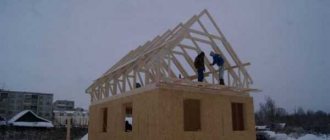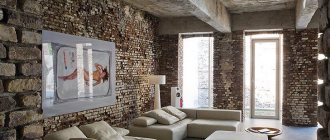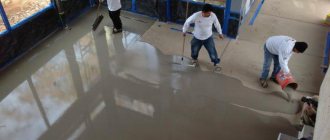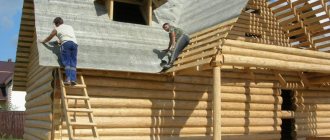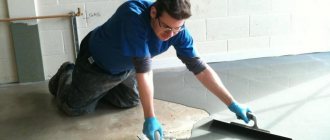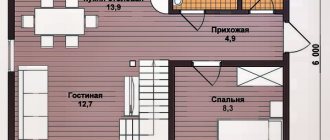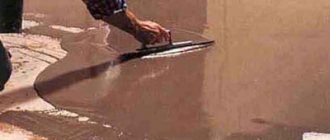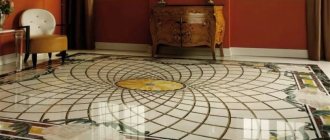Design features of the series and facade finishing
The external walls of P-42 are made of single-layer, but with an increased thickness of expanded clay concrete - up to 35 cm. The internal walls have a thickness of expanded clay concrete of 18 cm, and the interior partitions are made of gypsum concrete (12 cm). Interfloor ceilings are solid reinforced concrete slabs (14 cm). In a number of houses in the series, there is unsatisfactory quality of some interpanel seams and, as a result, poor thermal insulation of the premises.
The facades in P-42 tower-type “panels” were faced with large-sized tiles in light green or white. Most P-42 houses have one entrance, but there are also two-section buildings of this design, in which the sections are connected at an angle.
The roof of P-42 is flat, with an internal drain. Above the top floor there is a technical floor where engineering communications are located. The comfort of the houses is increased due to the presence of two elevators in each section - a passenger elevator and a cargo-passenger elevator designed for 500 kg. The fire safety of the building has also been improved - smoke-free staircases with exits to two special fire-resistant balconies have been designed in P-42.
Project 42 Falcon-class patrol ships [Kola class]
Built: 8
Modifications: no
| TO THE GENERAL LIST |
The experience of the Second World War, as well as the Great Patriotic War, was analyzed by the leadership of the Russian Navy and, in connection with this, adjustments were made to the patrol ships being designed and built. However, many projects were never implemented. The main reason was, obviously, the lack of a clear understanding of the purpose of ships of this class for the Russian Navy. In the leading countries of the world, dependent on maritime transport, TFRs were transformed into anti-submarine ships: escort destroyers, frigates and corvettes. It was they who made an important contribution to the defeat of the Axis submarine forces and ensured the sustainability of Allied maritime transport. Therefore, the importance and necessity of such ships in the USA, England and France was not in doubt. However, this experience could not be extended to the domestic Navy. Assessing the participation of surface ships of the Russian fleet in the Second World War, the leadership of the Navy did not have an unambiguous view specifically on the TFR of the pre-war project 39 . In the Black Sea, they were used in conjunction with Novik-type destroyers in all operations, but very rarely for their main purpose, and in the Baltic, their use was generally limited by the high mine danger. In the North, ships of the EM class and above were needed to guard external convoys, since in addition to the air and underwater threat, there was always a threat from the surface enemy. In addition, the northern theater, given the more stringent requirements for seaworthiness, which the then TFR, in particular, Project 39 , did not fully meet. In the coastal waters where inland convoys passed, there was a great mine threat and these ships had to be provided with minesweepers as well as transport. The experience of the Second World War showed that minesweepers and submarine hunters (MO and BO) were most effectively used for patrol duty and conducting internal convoys. Despite all these facts, obviously, due to tradition (since there is such a class of ship in the Navy, it is necessary to come up with tasks for it and continue their construction) or other reasons, in June 1947 a decision was made to develop the Project 42 . On July 29, 1946, the Commander-in-Chief of the Navy approved the technical specifications for the design of the TFR. This document defined the purpose of the ship: escorting convoys; performing patrol duty; participation in landing operations; laying minefields.
An important feature of the design of this SKR was that for the first time after 1917, the TTZ justification was carried out on a competitive basis by two design bureaus - TsKB-32 and TsKB-53. The design was carried out in two versions - with a diesel and steam turbine installation. The transformation of views on the TFR led to the fact that in the TTZ the displacement was finally set at 1300 tons with a cruising range of up to 2000 miles. At the same time, the 100-mm caliber artillery, traditional for domestic TFRs, was retained. The task for the development of the project was the Decree of the Council of Ministers of the USSR dated June 21, 1947. In the expanded TTZ, approved by the Commander-in-Chief of the Navy, only a steam turbine version of the power plant was already proposed. The design of the patrol ship was entrusted to TsKB-32 (Kaliningrad).
The technical design was completed by TsKB-32 in December 1947. The instability of views on the tasks was manifested in the fact that during the implementation of the technical design, at the request of the Navy, the option of placing minesweeping weapons on the ship was being worked out. The consideration of the technical project by the Navy dragged on until April 1948. The Navy Civil Code decided to approve the technical project without minesweeping weapons, while simultaneously increasing the stock of large depth charges to 48 pieces and increasing the number of bomb launchers to four. Thus, the idea of combining the functions of the SKR and the minesweeper (SKR-TSCH), which emerged from the experience of using ships in the Great Patriotic War, was temporarily discarded.
After a rather lengthy adjustment and development of the technical design, in the second half of 1948, preparation of the working design and SMEs began in Kaliningrad. The chief designer of Project 42 was D.D. Zhukovsky, the main observer from the Navy was Captain 1st Rank A.P. Sagoyan. The developed SKR project had several fundamental new solutions that were first introduced into domestic shipbuilding after 1917. For the first time in the domestic fleet, a project for a smooth-deck TFR was developed (a similar architecture was introduced somewhat earlier in the EM pr.41 pr.42 came into operation earlier ) with an all-welded hull. Also, for the first time, the propellers and two rudders of a ship of this class did not protrude beyond the main plane, and thus relatively safe navigation of the ship was ensured in the shallows and at river mouths. The presence of two rudders made it possible to ensure high agility.
For the first time, ships of this class were equipped with universal main-caliber artillery (100-mm B-34USM guns), which was extremely relevant given the constant growth of the air threat. Project 42 ships , for the first time in the practice of domestic shipbuilding, three-phase alternating current (50 Hz, 220 V) was introduced on a serial scale, which made it possible to use synchronous electric motors in electric drives, which are very reliable in operation, which are also lighter, cheaper and easier to manufacture than DC motors.
The ship's standard displacement was determined during testing to be 1339 tons. The draft of the ship, even with a full displacement of 3.36 m, allowed it to navigate inland waterways without preparing the underwater part (the last duty station of the 3 TFR of Project 42 was the Caspian Sea). The hull structures were made according to the strength standards of 1944. The absence of a forecastle made it possible to more efficiently use the material of the hull itself to ensure its overall strength. This circumstance was important after it was revealed during the Second World War that all our surface ships built after 1917 had weak hulls. The speed obtained during testing was higher than the design speed and amounted to 29.65 knots at full speed. Sea trials were carried out in sea conditions of 6 points and winds of 8...9 points on March 28, 1951 in the Bay of Gdansk. They showed that at speeds up to 24 knots, the loss of speed was only 0.5 knots, and the roll was less than that of the Project 30-bis . There was no flooding at all, and slight splashing was observed only occasionally. The ship's maneuverability was very good. Thus, the circulation diameter at full speed was only 4.7 ship lengths. This was achieved by having two rudders. During the period of running factory and state tests, due to vibration of the aft end of the ship, cracks were discovered in the frame and bulkheads in the area of 168-179 shp. Elimination of the identified damage was carried out by installing additional reinforcements in the area of 145-179 shp., in accordance with the drawings approved by the Central Research Institute named after. A.N. Krylov and 1st Central Research Institute of Moscow Region.
The arrangement of the mechanical installation was made in echelon with its placement in four compartments. Two turbo-gear units with a total power of 28,000 hp are used as the main engines. in a two-body design. Two main KV-42 triangular boilers provided a total steam output of 146 tons of steam per hour at an operating pressure of 28 kg/sq.cm and a superheated steam temperature of 370°C. Blowing is fan, into a closed boiler room. The cruising range at 13.7 knots with a full fuel supply of 300 tons was 2810 miles, and with the largest expended reserve of 360 tons it reached 3300 miles.
The ship is equipped with four universal 100-mm B-34USM artillery mounts and four 37-mm machine guns in two twin B-11M mounts. During firing, the mechanisms of the gun mounts worked satisfactorily, however, there was incomplete combustion of the phlegmatizer, the remains of which fell into the chamber part of the barrel, as a result of which, during the next loading, the cartridge did not reach the place, which caused the firing to be missed. To control the fire of artillery systems and machine guns, a Zenit-42 fire control device system was installed. The ship was temporarily equipped (due to the unavailability of the standard SVP-42) with an SVP-29-RLM gun aiming post, which had many shortcomings (because of this, the TFR only had SVPs with optical rangefinders, and the radars were dismantled). The three-tube torpedo tube installed on the ship provided firing only with forward-propelled steam-gas torpedoes of the 53-38U and 53-39 types at surface targets. If in the Second World War, even domestic destroyers only used torpedo weapons against surface targets a few times, then the assumption that the TFR would be able to use them in a future war was apparently wrong. For the first time, two RBM rocket launchers were placed on the ship already at the design stage. They had a constant elevation angle of 45 degrees. and the firing range is only 260 m. In this regard, the state commission expressed concern that due to the large circulation radius (about 2 cables) and the short firing range of the RBM (1.4 cables), it is possible for the ship to fall into the zone of explosions of salvo bombs if he will go at great speed. The commission considered it expedient to improve the rocket launcher by making it homing, stabilized by the throwing angle and with guidance based on data from a hydroacoustic station (GAS). The Rif radar had a dead zone of 2 cables, and the detection range of a surface target of the SKR class was 11 cables (20 km). The Guys-1M4 air target detection radar had a detection range for an air target of the light bomber type when flying at an altitude of 3000 m - 25 cabs (46 km). GAS "Tamir-5M" showed its specifications, i.e. the detection range of a submarine on the move was 16 knots, and on the move 18 knots was 11.7 cables. The only serious criticism received was the Fakel-M identification equipment, which was not accepted by the commission. The fact is that the response devices of this equipment are triggered by the operation of their stations and emit a signal code into the air without a request from the outside! All weapons and weapons could be used without restrictions with waves up to 4 points and with minor restrictions up to 6 points.
In the final protocol, the State Acceptance Commission for the lead ship of Project 42 noted: the ship fully meets its operational and tactical purpose; the available unspent displacement reserve in the presence of a stability margin can ensure, if necessary, the installation of additional 3 V-11M installations on the ship; SKR pr.42 , as having quite satisfactory seaworthiness, good wave surfability and controllability, and at the same time having a large sailing range, can be successfully used in the Northern and Far Eastern maritime theaters. However, the last three of them ended their service in the Caspian Sea already in the 1990s.
Despite all the positive results obtained during testing, SKR pr.42 was built in a limited series at one plant. Quite a lot of reasons can be found for the refusal of large-scale construction of these ships, and first of all the decision of the Chairman of the Council of Ministers of the USSR I.V. Stalin. There were many reasons for this decision. Some did not find documentary expression and remained only in fragmentary memories of the leaders of those years. First of all, the evolution of views on ships of this class from the top military and political leadership continued. The question arose again, to which there was no clear answer at that time: “What convoys were supposed to guard these ships?” After all, the development of the USSR economy in the post-war years was again focused on “all-round defense from the imperialists and complete autonomy of the state.” And for patrol duty and protection of small coastal convoys, smaller ships were required. Finally, in technical terms, these ships were not entirely modern due to a rather outdated power plant with blowing into the boiler room and relatively weak anti-submarine weapons. In any case, on the personal instructions of I.V. Stalin, the development of technical specifications for a new TFR with a full displacement of 1200 tons of Project 50 .
Modifications. During service on some ships of Project 42 , the SVP-29-RLM gun aiming post was replaced by SVP-42 with the Yakor-M fire control radar, the old general detection radar "Guys-1M4" was replaced by "Fut-N", RBM type bomb launchers were replaced with RBU-2500 “Smerch” with 128 RGB-25 ammunition.
Construction program. The lead SKR was laid down in Kaliningrad on August 17, 1949, launched on September 11, 1950, and entered service on June 29, 1951. Until 1953, the entire limited series of 8 units was built at the same Shipyard.
Status. TFR "Grif" and "Krechet" initially in 1952-53. were part of the Maritime Border Units of the USSR Ministry of State Security and served in the Barents Sea as PSKR, but on December 23, 1953 they were returned to the Navy. Two ships before being decommissioned in the 1970s. were used in the Caspian Sea as training ones. Three TFRs were converted into UTS, and one into PKZ. The lead ship of this project, the Falcon, was on the fleet lists until 1986; the rest were decommissioned in the 1960s and 70s.
| Photo gallery of SKR pr.42: | |||
SERIES:
| Name | salary | laid down | lowered | in service | excluded |
| "FALCON" (UTS-256) | 100 | 17.8.1949 | 11.9.1950 | 4.12.1952 | 20.6.1986 |
| "BEKUT" (UTS-7) | 101 | 25.4.1950 | 2.4.1951 | 10.5.1952 | 26.10.1965 |
| "CONDOR" | 102 | 28.6.1950 | 27.5.1951 | 10.5.1952 | 26.1.1970 |
| “GRIF” (“Soviet Azerbaijan”, PKZ-26) | 103 | 18.9.1950 | 3.9.1951 | 25.10.1952 | 21.5.1981 |
| "KRECHET" ("Soviet Dagestan") | 104 | 15.12.1950 | 27.11.1951 | 18.12.1952 | 28.6.1977 |
| "ORLAN" ("Soviet Turkmenistan") | 105 | 30.4.1951 | 9.5.1952 | 17.3.1953 | 22.11.1976 |
| "LION" (UTS-257) | 106 | 30.4.1951 | 24.5.1952 | 17.3.1953 | 18.8.1971 |
| "TIGER" | 107 | 1.7.1952 | 29.9.1952 | 25.4.1953 | 1.10.1974 |
BRIEF SERVICE HISTORY >>>
| MAIN TACTICAL AND TECHNICAL CHARACTERISTICS | |
| Displacement, tons: • standard • full | — 1 339 1 679 |
| Main dimensions, m: • maximum length (according to waterline) • maximum width (according to waterline) • maximum draft (average) | — 96,1 (90) 11 (10,25) 3,96 (3,14) |
| Main power plant: • 2 steam boilers KV-42, 2 GTZA total power, hp. (kW) • turbogenerators, power, (kW) • diesel generators, power, (kW) | boiler-turbine - 27,820 (20,450) 2 X 150 2 X 100 , 1 X 50 |
| 2 shafts; 2 propellers | — |
| Travel speed, knots: • highest • economic | — 29,6 13,7 |
| Cruising range, miles (at speed, knots) | 3300 (13,7) 670 (29) |
| Autonomy, days. | 10 |
| Crew, people (including officers) | 211 (14) |
| WEAPONS | |
| Artillery: • 100-mm AU B-34USM • 37-mm AU V-11M | — 4 X 1 2 X 2 |
| Torpedo: • 533-mm TA TTA-53-42 | — 1 X 3 |
| Anti-submarine: • RBM or RBU-2500 • BMB-1 • depth charges RBM ( or RGB-25) / BPS • bomb releasers | — 2 X 4 or 2 X 16 4 X 1 48 (128) / 36 (+12) 2 |
| Mine: • sea mines on deck overloaded | - up to 20 |
| RADIO-ELECTRONIC WEAPONS | |
| BIUS | • "Link-42" |
| NC detection radar | 1 x "Reef-1" |
| CC detection radar | 1 x “Guys-1M4” or “Fut-N” |
| navigation radar | 1 x "Vistula" |
| GAS | • "Tamir-5N" |
| electronic warfare equipment | "Bizan-4" RTR |
| Fire control radar | 1 x “Yakor-M” or “Vympel-2” for main battery artillery (as part of the SVP) |
| command and rangefinder posts | 1 x SVP-29-RLM or 1 x SVP-42 1 x RAS-U |
| means of communication | tool kit |
| State identification radar | • “Fakel-M” or “Nichrome” (“Nickel-K” + “Chrome-K”) |
Join our group “Courage 2004”
Share on social networks:
Features of apartment layouts
The layout of the apartments in P-42 is of a “corridor” type, and all rooms are isolated. Load-bearing walls are all external and inter-apartment (transverse and longitudinal). The advantage of apartments of the P-42 modification are large areas of kitchens and loggias, as well as separate bathrooms. Kitchens P-42 are already equipped with electric stoves upon delivery of the house.
However, the thermal insulation of apartments leaves much to be desired, and therefore, currently, during renovations, homeowners usually carry out additional insulation of external walls.
Prices for certain types of work when repairing a balcony or loggia on a turnkey basis
| Dismantling | Price |
| Dismantling: cutting down the threshold for the balcony, loggia | from 3000 to 7000 rub. |
| Dismantling: cutting down a quarter | from 2000 to 5000 rub. |
| Dismantling: cutting down the partition (permit required) | from 12,000 to 25,000 rub. |
| Dismantling glazing, paneling, furniture on the balcony | from 2000 rub. |
| Preliminary work | Price |
| Masonry with foam block (price with 70 mm material) | 1680 rub. / m2 |
| Welding work | 1500 rub. standard hour (min. 1500) |
| Finishing the parapet from the street side (price including material) | Price |
| Siding + sheathing made in Russia | 1800 rub. / m2 |
| Installation of lower ebb (width 150-200 mm) | 1500 rub. / m2 |
| Installation of parapet screen up to 250 mm (PVC) | 640 rub. / m2 |
| Installation of parapet screen over 250 mm (metal) | 1260 rub. / m2 |
| Perimeter sealing + flashing | 720 rub. / m2 |
| Glazing sealing | from 2500 rub. |
| Delivery of material | Price |
| Within the Moscow Ring Road | 3500 rub. |
| Beyond the Moscow Ring Road | From 4500 rub. and higher |
| Delivery within the 3rd ring | Plus 500 rub. |
| Lifting is paid separately to loaders at the rate | 300 rub. / 1st floor |

